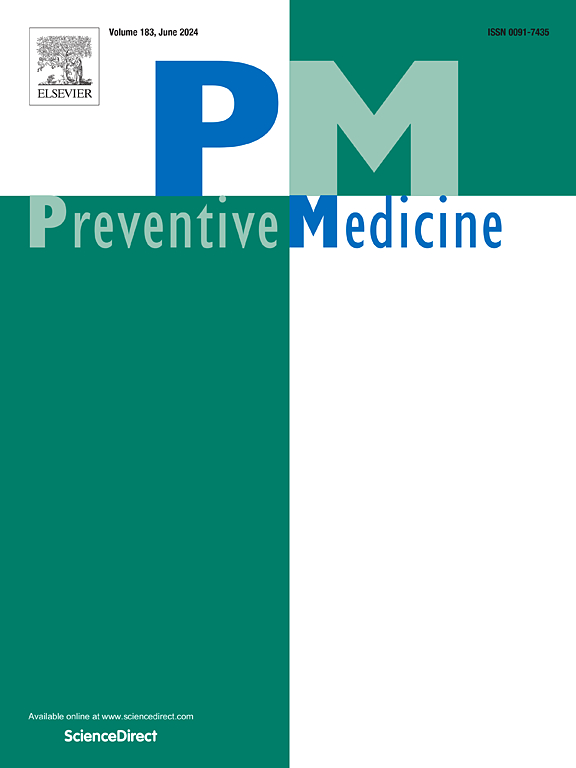芬兰有或没有代谢危险因素的中老年市政雇员健康行为和心血管疾病风险的变化:一项登记连锁队列研究
IF 3.2
2区 医学
Q1 MEDICINE, GENERAL & INTERNAL
引用次数: 0
摘要
目的:通过基线代谢危险因素(高血压、高胆固醇血症、肥胖、糖尿病)分层,探讨市政职工健康行为变化与心血管疾病(CVD)风险的关系。方法:对芬兰赫尔辛基4470名市政雇员进行随访(74% 为女性;中位年龄56.1 岁),平均11 岁(2007-2022年)来评估心血管疾病的发生率。生存曲线估计中位生存差异,风险比(hr)评估与吸烟、体育活动、饮酒、饮食和睡眠变化相关的心血管疾病风险。结果:随访期间,1879人(42 %)发生心血管疾病。在没有代谢危险因素的患者中,健康行为评分的改善与心血管疾病风险降低和中位生存期延长8.1年相关(HR = 0.59,95% % CI = 0.41-0.86)。在代谢危险因素组,最可观的减少从缺乏身体活动过渡到活动中观察高血压患者中(HR = 0.66,95 CI % = 0.49 - -0.87)、糖尿病(HR = 0.51,95 CI % = 0.30 - -0.87),和肥胖(HR = 0.63,95 CI % = 0.43 - -0.93)。结论:健康行为的改变与CVD风险相关,且随代谢因素的变化而变化。研究结果支持有针对性的干预措施,以促进行为改变,特别是增加有代谢风险的人的身体活动。本文章由计算机程序翻译,如有差异,请以英文原文为准。
Changes in health behaviors and risk of cardiovascular disease among midlife and aging municipal employees with and without metabolic risk factors: A register-linkage cohort study in Finland
Objective
To investigate associations between changes in health behaviors and cardiovascular disease (CVD) risk among municipal employees, stratified by baseline metabolic risk factors (hypertension, hypercholesterolemia, obesity, diabetes).
Methods
We followed 4470 municipal employees in Helsinki, Finland (74 % women; median age 56.1 years) for an average of 11 years (2007–2022) to assess incident CVD. Survival curves estimated median survival differences, and hazard ratios (HRs) evaluated CVD risk related to changes in smoking, physical activity, alcohol consumption, diet, and sleep.
Results
During the follow-up, 1879 (42 %) individuals developed CVD. Among those without metabolic risk factors, improvement in health behavior score was linked to reduced CVD risk and an 8.1-year longer median survival (HR = 0.59, 95 % CI = 0.41–0.86). Across metabolic risk-factor groups, the most considerable reductions were observed in the transition from physical inactivity to activity among individuals with hypertension (HR = 0.66, 95 % CI = 0.49–0.87), diabetes (HR = 0.51, 95 % CI = 0.30–0.87), and obesity (HR = 0.63, 95 % CI = 0.43–0.93).
Conclusions
Changes in health behaviors were associated with CVD risk, varying by metabolic factors. Findings support targeted interventions to promote behavior change, particularly increasing physical activity in those with metabolic risks.
求助全文
通过发布文献求助,成功后即可免费获取论文全文。
去求助
来源期刊

Preventive medicine
医学-公共卫生、环境卫生与职业卫生
CiteScore
7.70
自引率
3.90%
发文量
0
审稿时长
42 days
期刊介绍:
Founded in 1972 by Ernst Wynder, Preventive Medicine is an international scholarly journal that provides prompt publication of original articles on the science and practice of disease prevention, health promotion, and public health policymaking. Preventive Medicine aims to reward innovation. It will favor insightful observational studies, thoughtful explorations of health data, unsuspected new angles for existing hypotheses, robust randomized controlled trials, and impartial systematic reviews. Preventive Medicine''s ultimate goal is to publish research that will have an impact on the work of practitioners of disease prevention and health promotion, as well as of related disciplines.
 求助内容:
求助内容: 应助结果提醒方式:
应助结果提醒方式:


